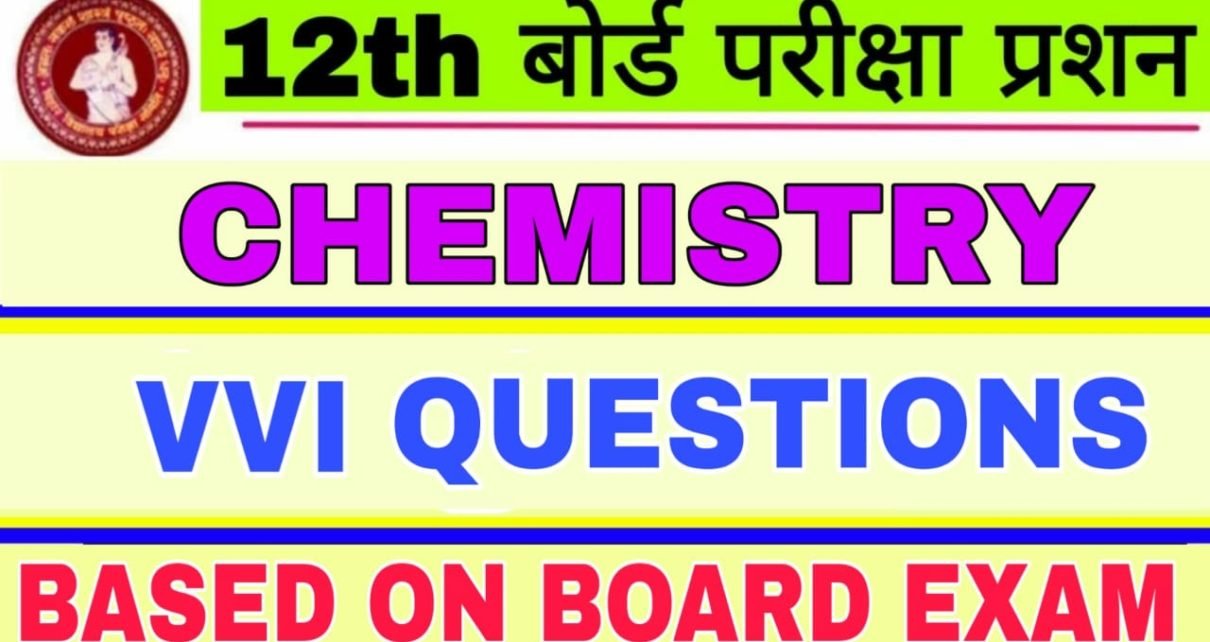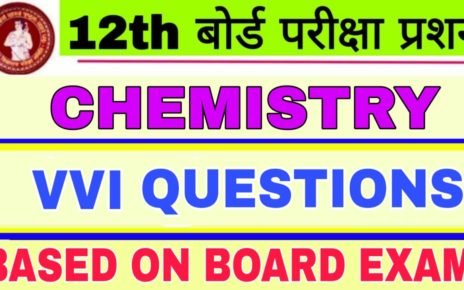12th Board Exam Chemistry (रसायन शास्त्र) महत्वपूर्ण प्रशन || BSEB 12th Board Exam Chemistry Short Type Question On latest Pattern Class Notes PDF Download,
1. What is the difference between “Schottky defect‘ and “Frenkel defect‘ ?
Ans. Difference between Schottky defect and Frenkel defect :
| Schottky defect | Frenkel defect |
| (i) The cations and anions are extinct from Lattice. | (i) Anions go to intersitial site, after vacant their place. |
| (ii) It minimize the density. | (ii) It does not any charge |
| (iii) This effect is in NaCl. | (iii) This defect is in AgBr. |
2. How do the antimicrobials control the microbial disease?
Ans. Antimicrobials control the microbial disease in three ways:
(i) Bactericidal drugs kill the organisms in the body.
(ii) Bacteriostatic drugs inhibit or arrest the growth of organisms .
(iii) Antimicrobials increase the immunity and resistance of infection of the body.
3. Classify the polymers on the basis of structures.
Ans. On the basis of structured polymers are classified as follows :-
(1) Linear polymers e.g. polyvinyl chloride, polythene etc.
(ii) Branched chain polyrners e.g. low density polythene.
(iii) Cross-liked polymers e.g. bakelite, melanine etc.
4. What is difference between the electrolytic cell & electrochemical cell.
Ans. Electrolytic cell & Electrochemical cell
| Electrolytic cell | Electrochemical cell |
| (i) This is used to convert electrical energy into chemical energy. | (i) This is used to convert chemical energy into electrical energy. |
| (ii) Anode is positive and cathode is negative | (ii) Cathode is positive and anode is negative. |
5. What is the role of ZnCl2 in a dry cell?
Ans. Zinc chloride ZnCl2 combines with NH3 released from NH4Cl present in the cell to form the complex salt [Zn(NH)3C12). Otherwise the pressure developed due to released NH3 would crack the seal of the cell.
6. What are emulsions? Describe different types of emulsions with example,
Ans. Emulsions are colloids in which both the dispersed phase and dispersion medium are liquids. Emulsions are of two types – oil–in–water type and water–in–oil type.
(i) Oil–in–water type emulsion : In this type of emulsions the dispersed phase is oil and the dispersion medium is water, Examples are mild in which fats are dispersed in water, vanishing cream is an another example.
(ii) Water–in–oil type emulsion : In this type of emulsions water in dispersed in oil which acts as dispersion medium. Examples are butter, cod–liver oil, cold cream etc.
7. What is refining and how liquation process is used for refining of metals?
Ans. The process of purifying the crude metals is called refining of metals. Low melting metals like tin and lead are refined by liquation since the melting points of these metals are lower than those of refining. The impure metals are melted on a sloping hearth of a furnace. Pure metals melt earlier than impurities and flow on the loping surface leaving behind the unmelted impurities.
8. Aldehydes are more reactive than ketones. Explain.
Ans. Due to smaller +I effect of the alkyl group in a aldehydes as compared to large +I effect of two alkyl groups in ketones, the magnitude of positive charge on the carbonyl carbon is more in aldehydes that ketones. As a result nucleophilic addition reaction occur more readily in aldehydes that in ketones.
As the number and size of the alkyl groups around C=0 group increases, there is steric hindrance which makes the attack of the nucleophile on the carbonyl carbon more difficult.
9. What is an antibiotic? Give the name of first antibiotic discovered.
Ans. Antibiotics are chemical substances produced wholly or partially by chemical synthesis which in low concentral either will or inhibit the growth or micro-organisms by vening the metabolic process. Penicillin was the first antibion discovered.
10. What is reverse osmosis ?
Ans. Reverse osmosis : If external pressure greater than osmotic pressure applied on solution, the flow of solvent molecules can be made proceed from the solution towards pure solvent. This type of osmosis is termed as reverse osmosis. Reverse osmosis is used for the distilation of sea water for getting fresh drinking water.
11. Differentiate between absorption and adsorption.
Ans. Difference between Adsorption and Absorption
| Adsorption | Absorption |
| (i) It is surface phenomenon, i.e. it occurs only at the surface of the adsorbent. | (i) It is bulk phenomenon, i.e., occurs throughout the body of the material. |
| (ii) In this phenomenon, the concentration on the surface of adsorbent is different from that in the bulk. | (ii) In this phenomenon, the concentration is same throughout the material. |
| (iii) Its rate is high in the beginning and then decreases till equilibrium in attained. | (iii) Its rate remain same throughout its process. |
12. Mention one use each of the following:
(a) Paracetamol (b) Tincture of iodine,
Ans. (a) Paracetamol–It reduces the temperature of the human body in the period of high fever.
(b) Tincture of iodine–It is a dilute solution of iodine prepaired in ethanol (2 to 3%), This chemical prevent the growth of micro–organisms and may also kill them.
13. “Explain two important uses of formalin.
Ans. Two important uses of formalin.
(i) It is used to preserve biological specimens.
(ii) It is used for the synthesis of bakelite.
14. Which one is stronger acid, HF or HCI ? Why?
Ans. HCl is stronger acid because it has big size and smaller electronegativity than HF.
15. Any transition series contains only ten elements. Why?
Ans. 3d and 4d transition series contains only ten elements because d orbital can contain maximum ten electrons.
16. Explain why H2O is neutral whereas H2S is acidic.
Ans. The size of central atom H2S is larger than that in H2O S–H bond is larger and weaker than 0–H bond H2O. hence H2S is more acidic than H2O.
📍 CHEMISTRY SHORT TYPE QUESTION PDF DOWNLOAD CLICK HERE
👉 PHYSICS CHAPTER WISE VVI OBJECTIVE TYPE QUESTION
👉 CHEMISTRY CHAPTER WISE VVI OBJECTIVE TYPE QUESTION
👉 BIOLOGY CHAPTER WISE VVI OBJECTIVE TYPE QUESTION
👉 MATH CHAPTER WISE VVI OBJECTIVE TYPE QUESTION
👉 HINDI 50 MARKS CHAPTER WISE VVI OBJECTIVE TYPE QUESTION
👉 ENGLISH 50 MARKS CHAPTER WISE VVI OBJECTIVE TYPE QUESTION
👉 ENGLISH 100 MARKS CHAPTER WISE VVI OBJECTIVE TYPE QUESTION
👉 HINDI 100 MARKS CHAPTER WISE VVI OBJECTIVE TYPE QUESTION
👉 BSEB 12TH EXAM ALL SUBJECT 10 PRACTICE MODEL SET PAPER WITH ANSWER
📍 CHEMISTRY SHORT TYPE QUESTION PDF DOWNLOAD IN HINDI MEDIUM CLICK HERE
👉 HINDI MEDIUM SHORT TYPE QUESTION CHEMISTRY 12TH BOARD EXAM


